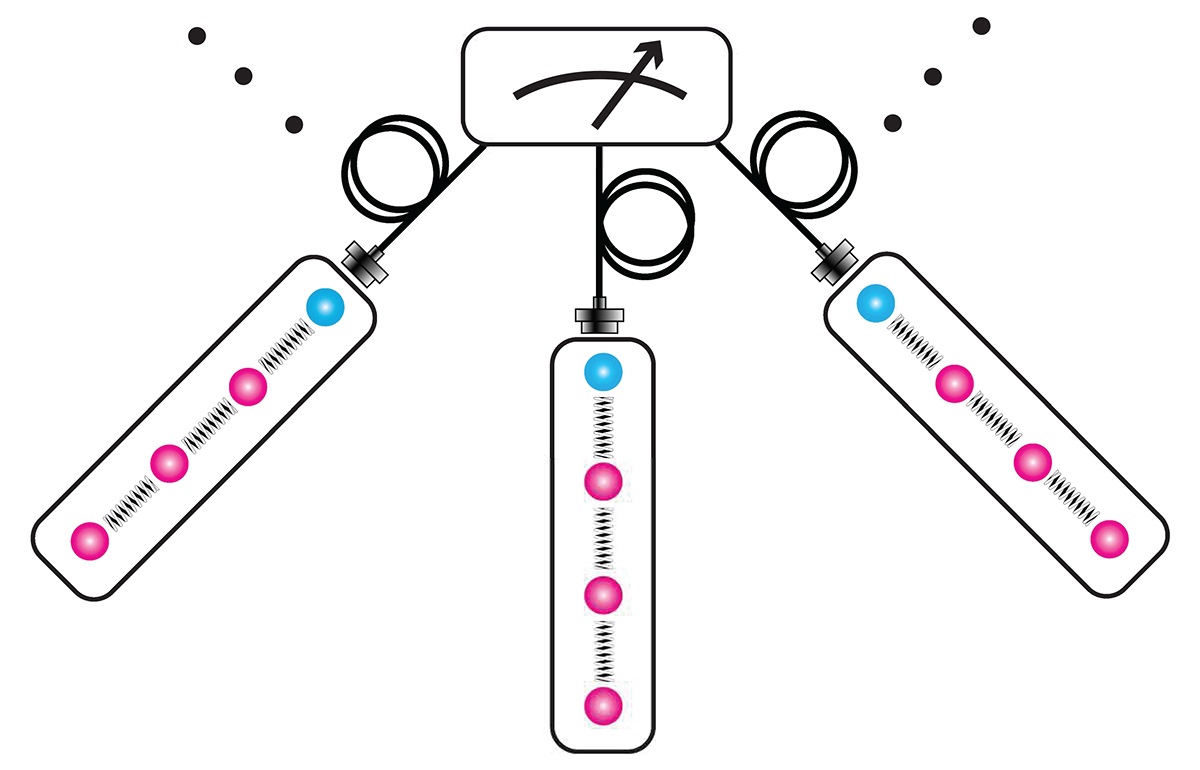July 12, 2017
Large-scale quantum computers, which are an active pursuit of many university labs and tech giants, remain years away. But that hasn’t stopped some scientists from thinking ahead, to a time when quantum computers might be linked together in a network or a single quantum computer might be split up across many interconnected nodes.
A group of physicists at the University of Maryland, working with JQI Fellow Christopher Monroe, are pursuing the second goal, attempting to wire up isolated modules of trapped atomic ions with light. They imagine many modules, each with a hundred or so ions, linked together to form a quantum computer that is inherently scalable: If you want a bigger computer, simply add more modules to the mix.
In a paper published recently in Physical Review Letters, Monroe and his collaborators reported on putting together many of the pieces needed to create such a module. It includes two different species of ions: an ytterbium ion for storing information and a barium ion for generating the light that communicates with other nodes.
This dual-species approach isolates the storage and communication tasks of a network node. With a single species, manipulating the communication ion with a laser could easily corrupt the storage ion. In several experiments, the researchers demonstrated that they could successfully isolate the two ions from each other, transfer information between them and capture light generated by both ions.
The light from the barium communication ion could eventually be routed through fiber optic cables to a reconfigurable sensor, where it would meet light from other nodes. To demonstrate that the module could produce this communication light, the team carefully excited the barium ion with a laser—leaving the ytterbium ion untouched—and captured the light emitted as it decayed. By observing both this emitted light and the ion, the team determined that the two were entangled, a requirement if the light is to carry messages in a quantum network.
The team also transferred information between the two ions, using their mutual electrical push and the resulting motion to intermingle the ions’ internal quantum characteristics. Using lasers to excite specific motion, the team showed how to swap information from one ion to the other and even entangle the two ions. Entangling the storage ion with the communication ion and the communication ion with outgoing light are the main ingredients needed for a node in a quantum network.
Using two different species came with some challenges, though. One problem to overcome was a size mismatch. Since ions give each other an electrical push, they wobble in a coordinated way when they are trapped next to each other. But ytterbium is heavier than barium, creating a mismatch in this motion that slows down the rate that information can be transferred from the ytterbium memory to the barium interface.
By analyzing this coupled motion, the team realized that using motion along the line connecting the two ions—something that is typically slower because ions aren’t as tightly confined in this direction—would speed up the information transfer.
The team has added memory ions to their module since the experiments they report in this work. But their main focus going forward will be to wire more modules together, with the eventual goal being a large-scale, modular quantum computer.
The paper has four authors in addition to Monroe: lead author and JQI graduate student Volkan Inlek, JQI graduate student Clayton Crocker, JQI postdoctoral researcher Marty Lichtman and JQI graduate student Ksenia Sosnova.
Story by Chris Cesare
Reference Publication
"Multispecies Trapped-Ion Node for Quantum Networking," I.V. Inlek, C. Crocker, M. Lichtman, K. Sosnova, C. Monroe, Phys. Rev. Lett., 118, 250502 (2017)













